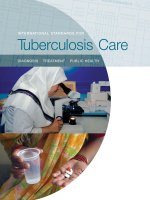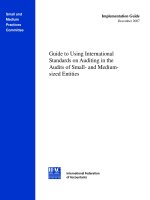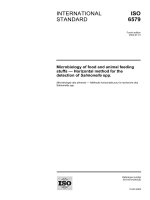ISO 76321985 International Standard
Bạn đang xem bản rút gọn của tài liệu. Xem và tải ngay bản đầy đủ của tài liệu tại đây (1.26 MB, 8 trang )
International Standard
INTERNATIONAL
ORGANIZATION
FOR STANDARDIZATION.ME>KLlYHAPOfiHAFl
OPTAHM3AWlR
l-l0 CTAHflAPTl43ALWlL1.ORGANlSATlON
INTERNATIONALE
DE NORMALISATION
seals for hydraulic
disc
Road vehicles - Elastomeric
brake cylinders
using a petroleum
base hydraulic
brake
120 OC max.)
fluid (service temperature
V&icules rou tiers - Joints en caoutchouc pour cylindres de freins hydrauliques ;i disgue utilisant un liquide de frein ;i base
p& troli&re (temp&a ture maximale d ‘u tilisa tion 120 oC)
First edition
iz
-
UDC
-
1985-06-15
629.113-592.2
: 678.06 : 621-762
Ref. No.
Descriptors
: road vehicles, braking systems, hydraulic brakes, disk brakes, hydraulic cylinders, rubber products,
tests, performance tests, marking.
IS0 76324985
(E)
seals (stoppers), O-ring seals,
Price based on 6 pages
Foreword
IS0 (the International Organization for Standardization) is a worldwide federation of
national standards bodies (IS0 member bodies). The work of preparing International
Standards is normally carried out through IS0 technical committees. Each member
body interested in a subject for which a technical committee has been established has
the right to be represented on that committee. International organizations, governmental and non-governmental, in liaison with ISO, also take part in the work.
Draft International Standards adopted by the technical committees are circulated to
the member bodies for approval before their acceptance as International Standards by
the IS0 Council. They are approved in accordance with IS0 procedures requiring at
least 75 % approval by the member bodies voting.
International Standard IS0 7632 was prepared by Technical Committee
Road vehicles.
0
International
Organization
Printed in Switzerland
for Standardization,
1985
lSO/TC 22,
INTERNATIONAL
STANDARD
IS0 76324985
(E)
seals for hydraulic
disc
Road vehicles - Elastomeric
brake cylinders
using a petroleum
base hydraulic
brake
fluid (service temperature
120 OC max.)
1
Scope
4.2
This International Standard specifies the performance test
methods and requirements for elastomeric seals used in road
vehicle disc brake cylinders, for use with petroleum base brake
fluid.
2
Field of application
This International Standard applies to solid section type seals
(square, rectangular, O-ring) mounted stationary in the cylinder
bore or on the movable piston of disc brakes.
These elastomeric seals shall be suitable for operation
temperature range of -40 to + 120 OC.
3
in a
4.2.1 Each seal shall bear a green mark specifying that it refers
to a category of seals for use with a petroleum base brake fluid.
4.2.2 The identification
elastomer.
IS0 48, Vulcanized rubbers - Determination
(Hardness between 30 and 85 IRHDJ.
IS0 188, Rubber, vulcanized resistance tests.
Accelerated
IS0 1817, Vulcanized rubber - Determination
liquids.
of hardness
ageing or heat-
of the effect of
IS0 7309, Road vehicles - Hydraulic braking systems - IS0
Reference petroleum base fluid.
IS0 7631, Road vehicles - Elastomeric cups and seals for
cylinders for hydraulic braking systems using a petroleum base
hydraulic brake fluid (service temperature 120 OC max. 1.
4.2.4 The green mark shall entail neither extra thickness nor
alteration of material characteristics; it shall remain during all
handling, before bringing the seal into use.
4.1
Product
Quality
Brake
test fluid
The test fluid shall be the reference fluid as defined in IS0 7309.
6
Apparatus
6.1 Resistance
physical
stability
to fluid at elevated
and precipitation
temperature,
characteristics
6.1.1 Oven, uniformly heated, dry air type conforming
requirements of IS0 188.
to the
6.1.2 Test jar, screw-top, straight-sided, round glass type,
having a capacity of 250 + 10 ml and inner dimensions of approximately 125 mm height and 50 mm diameter, with a tinned
steel lid (no insert or organic coating).
6.2
4
green mark can be ink or tinted
4.2.3 The place and type of green mark shall be the subject of
an agreement between buyer and seller.
5
References
Marking
High
temperature
stroking
test
requirement
and finish
Seals shall be free of blisters, pin-holes, cracks, embedded
foreign material, or other physical defects, and shall conform to
the dimensions specified on the drawings.
Apparatus as illustrated
with 6.1.1.
6.3
Low
temperature
in figure 1 with oven in accordance
leakage
Apparatus as illustrated in figure 2.
test
IS0 76324985
7
(El
Test requirements
7.1 After the test for resistance to fluid at elevated
temperature - physical stability (see clause 91, the seals shall
conform to the following requirements.
7.1.1
Any change in volume shall be within 0 to + 15 %.
7.1.2 Any
+8 IRHD.
change
in hardness
shall
be within
-7
to
7.2 After the test for resistance to fluid at elevated
temperature - precipitation characteristics (see clause 101, not
more than 0,3 % sediment by volume shall be formed in the
test fluid used.
7.3 After the test for resistance to elevated temperature in
dry air (see clause 111, the seals shall conform to the following
requirements.
7.3.1
Any change in hardness shall be within 0 to +20 IRHD.
7.7.2 No surface of the sealing systems shall show evidence
of corrosion or deterioration which would interfere with proper
sealing action. Normal staining or discoloration of metal parts is
acceptable if surface finish is unaffected.
7.8 After all tests, disassemble the cylinder
seal. Record the visual condition of the seal,
Seals shall not show excessive deterioration
scuffing, blistering, or change in shape from
8
7.4 After the ambient temperature
stroking test (see
clause 121, seals and assembly shall conform to the following
requirements.
7.4.1 No leakage beyond normal wetting of the bore( s) shall
occur duri ng the stroking test.
7.4.2 No leakage beyond normal wetting of the bore(s) shall
occur during the static leak test in 12.2.6.
7.5 After the high temperature stroking test (see clause 131,
the seals and assembly shall conform to the following requirements.
7.5.1 No leakage beyond normal wetting of the bore(s) shall
occu during the stroking test.
7.5.2 No leakage beyond normal wetting of the bore(s) shall
occur during the static leak test in 13.2.9.
7.6 After the low temperature leakage test (see clause 141,
the seals and assembly shall conform to the following requirements.
7.6.1 No leakage beyond normal wetting of the bo Ire(s) shall
occur during the test period or pressure application.
7.7 After the cycling humidity storage corrosion test (see
clause 151, the seals and assembly shall conform to the following requirements.
7.1.1 No evidence of rubber adhesion of the test
appear during disassembly of the test brake.
2
s)
of test specimens
All seals to be tested shall be cleaned prior to testing by rinsing
in hexane and blown dry or wiped dry with a lint-free cloth.
Seals shall not remain in the hexane for more than 10 s.
9 Resistance
to fluid at elevated
temperature
- Physical stability
9.1
7.3.2 Seal condition : test specimens shall show no evidence
of blistering, cracking, or change in shape from original.
Preparation
and inspect the
bore and piston.
such as scoring,
original.
Test
specimens
From three or more seals to be tested, obtain a sample of mass
3to 5 g.
9.2
Procedure
9.2.1 Determine and record the initial volume of the sample in
accordance with IS0 1817.
9.2.2 Determine and record the initial IRHD hardness of the
sample. Measure hardness as described in IS0 48 using a
microtester (or according to a procedure previously agreed
upon between vendor and purchaser).
9.2.3 Place the sample in the test jar (6.1.2) and completely
immerse in 75 ml of brake test fluid (see clause 5). Seal the test
jar to prevent vapour loss and place in the oven (6.1.1) at
120 + 2 OC for 70 h.
9.2.4 After 70 h, remove the test jar from the oven and allow
the sample to cool in the test jar at 23 + 5 OC for 60 to 90 min.
At the end of the cooling period, remove the sample from the
test jar, rinse in hexane and wipe dry with a clean, lint-free
cloth.
Do not allow the sample to remain in the hexane for more than
10 s.
9.2.5 Determine and record within 60 min the final volume
and IRHD hardness of each seal in accordance with 9.2.1 and
9.2.2.
9.2.6 The change in volume is given, as a percentage of the
original volume, by the formula
(m 3 - ~12~1- (ml - m2)
bq
- m2)
x 100
lSO7632-1985(E)
11.2.3 At the termination of the heating period, remove the
seals from the oven and allow to cool for 16 to 96 h at room
temperature.
where
ml
is the initial mass, in grams, in air;
m2
is the initial apparent mass, in grams, in water;
m3 is the mass, in grams, in air after immersion in test
fluid;
m4 is the apparent mass, in grams, in water after immersion in test fluid.
Test
From two
4 + 0,5 g.
be cut from
number of
10.2
12
Ambient
12.1
10 Resistance
to fluid at elevated
characteristics
temperature
- Precipitation
10.1
11.2.4 After cooling, measure and record the IRHD hardness
in accordance with 9.2.2 and note any visual change such as
cracking, blistering, distortion, etc.
Test
or more seals to be tested, obtain a sample of
Since whole seals are quite large, small pieces may
the seal to reach the required mass. Use a minimum
pieces to obtain a mass of 4 + 0,5 g.
12.2
Procedure
12.2. 1 Moisten the seals and cylinder bo ires with brake test
fluid (see clause 5). Install the test seals in the cylinder.
12.2.2 Complete test cylinder assembly, placing the piston to
simulate a half-worn lining position.
Procedure
10.2.3 Rotate the centrifuge tube for 30 min at 1 500 min -1.
Note the volume of sediment observed in the tube. Repeat the
above rotation for an additional 30 min and record any difference in volume of sediment.
10.2.4 Record the percentage amount of sediment obtained
after the second centrifuging.
12.2.3 Mount the test cylinder assembly on a production hub
and disc assembly or equivalent simulating fixture.
12.2.4 Connect the test fixture to the pressure source. It may
be necessary or desirable to include a fluid accumulator (see
IS0 7631).
12.2.5
12.2.5.1
Resistance
Test
to elevated
temperature
in dry
Test parameters
Temperature
: 18 to 32 OC.
12.2.5.2 Pressure : Apply pressure by external means at a
maximum rate of pressure rise of 21,0 + I,4 MPa/s from 0 to
7,0 + 0,3 MPa.
12.2.5.3
Cycles required : 500 000 total.
12.2.5.4
Cycle rate : 3 600/h + 10 %.
12.2.6
Leakage test
Observe leakage during and after the stroking test. After completion of the stroking test, run high and low pressure leak
tests.
specimens
Two or more seals shall be used.
11.2
for at least one complete cylinder shall be
specimens
10.2.2 After 70 h, remove the test jar from the oven. Allow
the sample to remain in the fluid at room temperature for 24 h,
then shake the test fluid and pour into a cone-shaped centrif uge tube.
11.1
stroking
specimen
Adequate
prepared.
10.2.1 Place the sample in a test jar (6.1.2) and cover with
75 ml of the test fluid (see clause 5). Seal the test jar to prevent
vapour loss and place in the oven (6.1 .I) at 120 + 2 OC. (Optional : a blank test may be conducted on the brake fluid prior
to the test, and any sediment resulting from this blank test may
be deducted from the volume of sediment obtained after the
test. 1
11
air
temperature
Procedure
11.2.1 Measure and record the IRHD hardness of each in accordance with 9.2.2.
11.2.2 Place the test seals in a circulating air oven, as described in IS0 188, and maintain at 120 + 2 OC for 70 h.
12.2.6.1
High pressure leak test
Apply 0,7 MPa hydraulic pressure for 5 min and observe .and
record leakage, if any.
12.2.6.2
Low pressure leak test
Remove the cylinder from the test stand and connect the test
cylinder to a pressure source at 10 + I,75 kPa for 24 h.
Observe leakage, if any.
3
IS0 76324985 (El
NOTE - The pressure source may be a static column of fluid. A
1 200 mm column will provide 10 kPa
12.2.7 Disassemble the cylinder and inspect the seal. Record
the visual condition of the seal, bore and piston. Seals shall not
show excessive deterioration such as scoring, scuffing, blister
ing, cracking, or change in shape from original.
13
High temperature
13.1
Test
stroking
test
13.2.9
Observe leakage during and after the 70 h stroking test. After
completion of the 25 h cooling period, carry out a high and low
pressure leak test.
13.2.9.2
13.2.2 Complete test cylinder assembly, placing the pisto n to
simulate a half-worn lining position.
13.2.3 Mount the test cylinder assembly on a production hub
and disc assembly or equivalent simulatin g fixture.
13.2.4 Place the complete test fixture in an oven conforming
to clause 4 of IS0 188 (see also figure 1).
NOTE - The Iow pressure source may be a static column of fluid. A
1 200 mm colu mn will provide 10 kPa.
13.2.10 Disassemble the cylinder and inspect the seal. Record
the visual condition of the seal, bore and piston. Seals shall not
show excessive deterioration such as scoring, scuffing, blistering, cracking or change in shape from original.
14
14.1
Low temperature
Test
leakage
test
specimens
Connect to the pressure device.
The device may be composed of a pneumatically or hydraulically actuated automotive type master cylinder the rate of
operation of which shall be set at 1 000 + 100 strokes/h.
The test fixture shall be connected to the actuating pressure
device and arranged so as to yield a maximum rate-of-pressure
rise of 7,0 MPa/s, and a minimum dwell period below
0,18 MPa of 0,25 s. (It may be found necessary to install a fluid
accumulator, such as a standard wheel cylinder as in IS0 7631,
to meet the required pressure/displacement
curve. 1
13.2.6.1
Low pressure leak test
Remove the cylinder from the test stand and connect the test
cylinder to a pressure source at 10 + 3,3 kPa for 24 h. Observe
leakage, if any.
13.2. 1 Moisten the seals and cylinder bores with brake test
fluid (see clause 5). Install the test seals in the cylinder.
13.2.6
High pressure leak test
Apply 0,7 MPa hydraulic pressure for 5 min and observe and
record leakage, if any.
specimens
Procedure
73.2.5
Leakage test
13.2.9.1
Adequate test seals for at least one complete cylinder shall be
prepared.
13.2
13.2.8 After a 60 min cooling period, remove the test
assembly and allow it to complete cooling in the open air for
25 + 5h.
Adequate test seals for at
prepared.
14.2
one complete cylind er shall be
Procedure
14.2. 1 Moisten the seals and cylinder bores with bra ke test
fluid (see clause 5). Install the test seals in the cylinder
14.2.2 Complete the test cylinder assembly, placing the
piston to simulate a new lining position. Arrangements shall be
made to change the piston position during the cold test to
simulate new, half, two-thirds, and fully worn lining positions.
Test parameters
Temperature
14.2 .3 Mount the test cylinder assembly on a production
and disc assembly or equivalent simulating fixture.
: 120 f: 2 OC.
13.2.6.2 Pressure : 7,0 + 0,3 MPa at a rate-of-pressure
of 7,0 MPals max.
13.2.6.3
Elapsed time : 70 h.
13.2.6.4
Cycles required : 70 000 + 5 000.
rise
13.2.7 After 70 h, discontinue stroking, shut off the heat,
open the oven door, release hydraulic pressure in the system
and allow the oven to cool for 60 min. The circulating fan may
be left on to aid in cooling.
14.2.4 Place the test
-43 OC and connect
figure 2. The pressure
static reservoir head of
fixture
to the
source
300 to
in a cold chamber at -40 to
pressure source as shown in
shall be located to provide a
600 mm.
14.2.5 Allow the cylinder to soak for 72 h with the piston in
the new lining position.
14.2.6 After 72 h, operate the stroking mechanism six times
at 1 rf: 0,07 MPa followed by six times at 4,2 rf: 0,35 MPa. The
strokes shall be held for approximately 5 s and applied ap-
IS0 76324985
proximately 60 s apart. Immediately after stroking, remove the
first shims and by means of the stroking mechanism, move the
pistons into half-worn lining position using minimum line
pressure to establish the new location for all pistons. Observe
and record leakage, if any, 30 min after the new position is
established. Allow the test cylinder to continue to soak for
24 h.
(E)
15.2.2 Complete the test cylinder assembly, placing the
piston to simulate a half-worn lining position. The cylinder
assembly need not be assembled’to a hub or test fixture as long
as provisions are made to hold the pistons in their correct positions and boots are properly installed.
14.2.7 After 96 ‘h total soaking time, repeat 14.2.6, but at the
two-thirds worn lining position.
15.2.3 Place the test cylinder in a humidity chamber capable
of maintaining 95 + 2 % relative humidity and a temperature
range of 21 to 46 OC. The cylinder should be placed with the
inlet port open and facing down.
14.2.8 After 120 h total soaking time, repeat 14.2.6, but at the
fully worn lining position; discontinue the test 30 min after
establishing final piston position.
15.2.4 Maintain the cylinder at 43 to 46 OC and 95 + 2 %
humidity for 16 h.
14.2.9 Disassemble the cylinder and inspect the seal. Record
the visual condition of the seal, bore and piston. Seals shall not
show excessive deterioration such as scoring, scuffing, blistering, cracking, or change in shape from original.
15
15.1
Cycling
Test
humidity
storage
corrosion
test
15.2.6 Continue the above 24 h cycle for 12 days. When interrupted by one or more non-working days, maintain in accordance with 15.2.5 until the temperature cycling can be
resumed.
specimens
Adequate test seals for at least one complete cylinder shall be
prepared.
15.2
15.2.5 Change the temperature to 18 to 21 OC while maintaining 95 + 2 % relative humidity, and maintain for 8 h.
15.2.7 At the conclusion of the 12 days test, remove the test
cylinder for disassembly and inspection. Do not rotate the
cylinder, and where possible, disassemble while holding in the
test position.
Procedure
15.2.1 Moisten the seals and cylinder with IS0 reference
petroleum base hydraulic fluid (see IS0 7309). Install the test
seals in the cylinder.
15.2.8 Inspect and note all components for corrosion, pitting,
adhesion and other deleterious factors resulting from corrosion
and/or interaction between the materials involved.
Pressure gauge
Master cylinder
’
/
Ad=%
?neumatic or
hydraulic pressure
source
Cylinder assembly 1
Oven chamber at + 120 OC
Figure 1 -
High temperature
L
Wheel cylinder seal
stroking fixture
stroking
test
5
IS0 76324985
(El
t
E
z
a
0
Master
cylinder
Hydraulic
pressure 1
0
0
m
Cylinder assembly
Cold chamber at -40 OC
Figure 2 -
Low temperature
leakage
test









